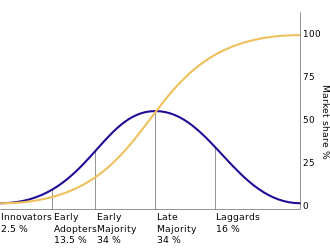Diffusion of Innovation
Everett Rogers, a notable communication theorist and professor, theorized the diffusion of innovations in his 1962 book, Diffusion of Innovations. The theory seeks to analyze how new ideas and technologies spread throughout society. There are five main categories to this theory: (1) pioneers, (2) early adopters, (3) early majority, (4) late majority, and (5) laggards.
The theory can be applied to any ideas, including that of women's suffrage in the United States. In this post, I will explore the ways in which the diffusion of innovations can be applied to the idea of women within the United States earning their right to vote.
Applying the Theory to Women's Suffrage
Step 1: The Pioneers
The first step of the theory is innovation. During this step, those who act as the pioneers willingly take risks in order to achieve their goals. The beginning of the women's suffrage movement in the United States exemplifies this step. The road to women's suffrage in the United States began in July 1848 with the Seneca Falls Convention. Prior to the convention, feminists Lucretia Mott, Martha C. Wright, Elizabeth Cady Stanton, and Mary Ann McClintock met to assemble the Declaration of Sentiments. The declaration, modeled after the Declaration of Independence, explained the rights women should have as citizens of the United States. It begins by stating that both men and women should have unalienable rights to life, liberty, and the pursuit of happiness. It continues by illustrating the 16 ways that women are oppressed.
 |
1848 Senaca Falls Convention |
Step 2: Early Adopters
Next is the early adopters. In this step, those who are known to have a higher social status join in on the innovation. Once Stanton announced the declaration at the convention, one hundred of the attendees signed, including Frederick Douglass. The signing of the declaration marked the start of the women's rights movement. 19 years after the convention, in 1867, the
15th Amendment was drafted; which was strongly opposed by Stanton, Susan B. Anthony, Sojourner Truth, and other feminists. They made the racist claim that women should be granted the right to vote before former slaves. Other feminists, such as Lucy Stone, disagreed.
Step 3: Early Majority
After the early adopters comes the early majority. While in this step, those who have an average social status connect with the early adopters in order to hold a position of leadership. The disagreement between between the groups led to the formation of two different suffrage organizations: Stone's American Woman Suffrage Association (AWSA) and Stanton and Anthony's National Woman Suffrage Association (NWSA). In 1890, the two competing organizations decide to merge, becoming the National American Woman Suffrage Association (NAWSA).
Step 4: Late Majority
The fourth step to the diffusion of innovations is the inclusion of late adopters. They adopt the innovation after the average participant. This step is also known as the "tipping point." The 1920 passage of the 19th Amendment, which guaranteed woman the right to vote, is an example of this.
Step 5: Laggards
The final part of the diffusion of innovations is the laggards. Laggards are those who typically do not desire change. Despite the passing of the 19th, women have (and still are) campaigning for the passage of the
Equal Rights Amendment. The amendment, first proposed in 1921 by Alice Paul, states that "equality of rights under the law shall not be denied or abridged by the United States or by any State on account of sex." In 1970, the amendment passed the House of Representatives. In 1972, it passed the Senate and went to the states for ratification. However, it received 35 of the necessary 38 state ratifications; ultimately making it fail. Although women have been given more rights, there is more work needed to be done in order to achieve equality.
Works Cited
Blakemore, Erin. “Five Things to Know About the Declaration of Sentiments.” Smithsonian.com, Smithsonian Institution, 8 June 2016, www.smithsonianmag.com/smart-news/five-things-know-about-declaration-sentiments-180959352/.
Cokey, Carrie L. Declaration of Sentiments. 27 Dec. 2017, www.britannica.com/event/Declaration-of-Sentiments.
“Diffusion of Innovations.” Wikipedia, Wikimedia Foundation, 11 Nov. 2020, en.wikipedia.org/wiki/Diffusion_of_innovations.
Schuessler, Jennifer. “The Complex History of the Women's Suffrage Movement.” The New York Times, The New York Times, 15 Aug. 2019, www.nytimes.com/2019/08/15/arts/design/womens-suffrage-movement.html.
“US Women's Suffrage Timeline 1648 to 2016 (U.S. National Park Service).” National Parks Service, U.S. Department of the Interior, 4 Aug. 2020, www.nps.gov/articles/us-suffrage-timeline-1648-to-2016.htm.


No comments:
Post a Comment